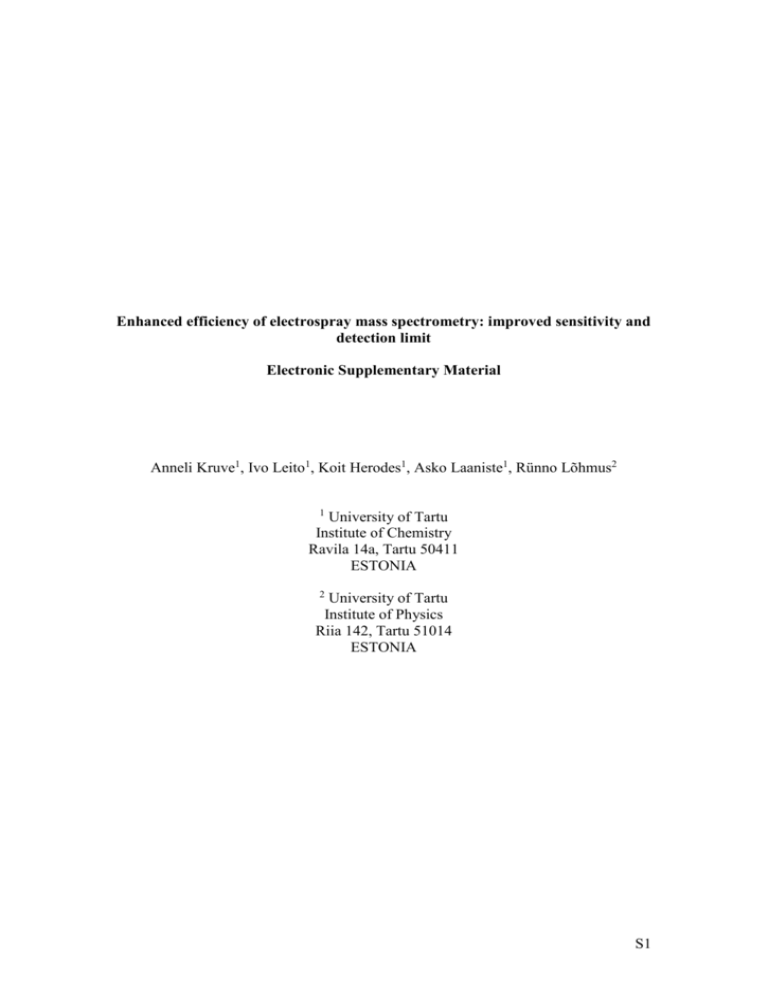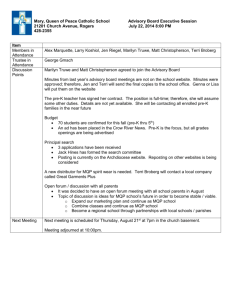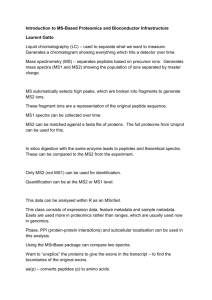Supplementary Information - Springer Static Content Server
advertisement

Enhanced efficiency of electrospray mass spectrometry: improved sensitivity and detection limit Electronic Supplementary Material Anneli Kruve1, Ivo Leito1, Koit Herodes1, Asko Laaniste1, Rünno Lõhmus2 1 University of Tartu Institute of Chemistry Ravila 14a, Tartu 50411 ESTONIA 2 University of Tartu Institute of Physics Riia 142, Tartu 51014 ESTONIA S1 Chemicals Methanol (J.T.Baker, Deventer, The Netherlands) and pH = 2.8 buffer solution were used for preparation of LC/MS eluent. The buffer solution was made of 1 mM ammonium acetate (Fluka Chemie AG, Buchs, Germany) and 0.1% formic acid (Fluka, Germany) dissolved in water purified with Millipore Milli-Q Advantage A10 (Millipore, USA). For sample preparation magnesium sulfate (Lach-Ner, Neratovice, Czech Republic) and sodium acetate (Reahim; Leningrad, now St Petersburg; Soviet Union, now Russia) and acetonitrile (J.T.Baker, Deventer, The Netherlands) were used. Acetonitrile was acidified with glacial acetic acid (Lach-Ner, Neratovice, Czech Republic). Also Primary Secondary Amine (PSA) sorbent (Supelco, Bellefonte, USA) was used in the QuEChERS method. Pesticide standard substances were obtained from Dr. Ehrenstorfer GmbH (Augsburg, Germany). Stock solutions of approximately 1000 mg/kg in acetonitrile were prepared. For carbendazim the stock solution was 300 mg/kg. The working standard contained 4 pesticides (carbendazim, thiabendazole, imazalil and methiocarb). For spiking appropriate dilutions were made. Post-extraction spiked samples used in this work were prepared according to buffered QuEChERS method described by Kruve et al [12]. Liquid Chromatography The spiked extracts and standard solutions were analyzed with Agilent Series 1100 LC/MSD Trap XCT (Agilent Technologies, Santa-Clara, USA). The LC instrument was equipped with a binary pump, autosampler, thermostated column compartment. The effluent passed through diode array detector before reaching the mass spectrometer. The mass spectrometer uses quadrupole ion trap mass analyzer. For instrument control Agilent ChemStation for LC Rev. A. 10.02 and MSD Trap Control version 5.2 were used. Chromatographic separation was carried out on 250 mm long Zorbax Eclipse XDBC18 column, with internal diameter 4.6 mm and particle size 5 μm. An Eclipse XDBC18 12.5 mm long precolumn was used with internal diameter 4.6 mm and particle size 5 μm. The autosampler injection volume was set to 10 μl. Gradient elution with methanol and buffer solution (pH = 2.8) was used. The linear gradient started at 20% methanol and was raised to 100% within 15 min then the column was eluted 7 min with methanol. After that the methanol content was lowered to 20% in 3 min. Stabilization time of 7 min was used between injections. Eluent flow rate was 0.8 ml/min. The retention times for carbendazim, thiabendazole, imazalil and methiocarb were 8.3, 9.5, 13.7 and 16.5 min respectively. Mass spectrometer Agilent XCT Ion Trap MS was used. All of the analyses were carried out in positive mode. The mass spectrometer was operated in the selected reaction monitoring mode (SRM). Full MS2 spectra were recorded. Each fragmentation was observed independently in a separate time window. Observed MS2 were independent of the nebulizer used. MS2 spectra were recorded. For quantitation the following transitions were followed: 192.0 -> 160.0, 202.0 -> 175.0, 297.0 -> 201.0 and 226.0 -> 169.0 for carbendazim, thiodicarb, imazalil and methiocarb, respectively. The MS parameters were first optimized separately for each nebulizer design at the chromatographic flow rate according to the process described by Kruve et al [14]. The S2 parameters were separately optimized for both designs – with and without the capillary C. The parameters are listed in Table A.1. Signal-to-noise ratios were obtained with Data Analysis software version 5.2, which calculates noise over the whole chromatogram except the peaks. Nebulizer configuration Figure A.1 Cross-sectional view of the developed nebulizer (Design 2). S3 Optimization of the gas parameters Both the gas flow in capillary A as well as in capillary C were optimized. For this optimization one pesticide – imazalil – was used at different solvent compositions. It was assumed that gas flow rate optima are independent of the analyte used. The optimization plots are presented in the Figures A.2 ja A.3. It was found for the nebulizer design 2 that at optimal conditions the gas flow in capillary C should be as high as possible (due to instrumental limitations) – 300 mL/min – and in capillary A lowest possible allowed by the software – 3.8 L/min. The gas flow rate was also optimized for the nebulizer with only one gas supply (nebulizer design 1) – capillary A. The optimal flow rate was found to be – 28.5 L/min – the highest flow rate possible due to the instrumental limitations. From these optima it can be seen that the gas flow in capillary C is much more effective in assisting nebulization than the gas flow in capillary A – a significantly lower (by ca 7 times) flow rate is sufficient. This demonstrates that even though the dimensions of the capillaries in the nebulizer are not optimized the inner capillary C does lead to an improved nebulization. S4 Figure A.2 Optimization of the gas flow rate in capillary A for a) design 1 without capillary C and b) design 2 with capillary C (with gas flow from C fixed to 300 ml/min). Each point (intersection of two lines) represents the average of three measurements. 2.5E+05 2.0E+05 1.5E+05 MS signal 1.0E+05 5.0E+04 22.8 28.5 100% 80% 60% 19 40% 15.2 Capillary A gas flow (l/min) 20% 11.4 20% 7.6 5% 3.8 28.5 5% 0.0E+00 % MeOH in eluent 2.5E+06 2.0E+06 1.5E+06 MS signal 1.0E+06 5.0E+05 100% 80% 60% 40% 19 22.8 Capillary A gas flow (l/m in) 15.2 11.4 7.6 3.8 0.0E+00 % MeOH in eluent Figure A.3 The MS signal intensity dependence on the gas flow rate in Capillary C at different effluent compositions. Each point (intersection of two lines) represents the average of three measurements. S5 4.E+06 3.E+06 2.E+06 2.E+06 MS Signal 3.E+06 1.E+06 5.E+05 273 218 164 109 55 20 % MeOH Gas flow rate (ml/min) 5 0 100 80 60 40 0.E+00 From Figure A.2 and A.3 it can be seen that if capillary C is not used (Figure A.2 a), independent of the eluent composition, in Capillary A the highest possible nebulizer gas flow rate must be applied in order to achieve the highest sensitivity. On the other hand, when Capillary C is applied and used in its optimal conditions (optimization results presented in Figure A.3) the nebulizer gas flow rate in Capillary A (Figure A.2 b) needs to be the lowest possible. It can be seen that increasing gas flow rate in capillary A in the case of design 2 leads to decrease of sensitivity. This indicates that gas flow from capillary C alone provides sufficient nebulization and additional gas from capillary A blows the droplets away from the ionization chamber too fast and therefore the signal tends to decrease at higher Capillary A gas flow rates. MS parameter optimization The MS parameter optimization was carried out via software. The chromatographic eluent flow rate 0.8 ml/min and the eluent composition corresponding to elution of the respective pesticide from the column were used. The optimal MS parameters are described in Table A.1 for both nebulizer designs. S6 Table A.1 MS parameters optimized for designs 1 and 2. Optimization was carried out at chromatographic flow rates and effluent composition corresponded to the elution effluent. Design 1 (nebulizer gas flow rate 28.5 l/min and no Capillary C) (V)1 Capillary Skimmer (V) Cap Exit (V) Oct 1DC (V) Oct 2DC (V) Trap Drive Oct RF (Vpp) Lens 1 (V) Lens 2 (V) Frag Ampl Frag Cut Off 1 Cabendazime Thiabendazole 5000 5000 41.48 41.48 88.52 152.46 10.82 11.39 1.23 1.31 36.41 53 118.03 78.69 0 -8.11 -57.21 -100 1.69 1.16 81.84 101 Imazalil 5000 45.66 157.38 13.69 2.62 71.85 83.61 -4.92 -100 0.58 114.9 Design 2 (capillary C gas flow rate 300 ml/min and nebulizer gas flow rate 3.8 l/min) Methiocarb Cabendazime Thiabendazole 5000 2704.92 2762.29 66.56 43.03 59.67 113.11 76.72 129.84 11.39 13.11 16.2 3.18 0.43 0 53 27.48 36.18 83.61 103.28 118.03 0 -4.84 -4.34 -32.13 -85.25 -97.05 0.5 0.65 1.23 113 84.04 104.97 Imazalil 2704.92 50.16 129.84 14.59 1.12 42.42 152.46 -5.33 -74.92 2.12 125.13 Methiocarb 2991.8 43.03 76.72 8.15 1.07 39.3 78.69 -4.84 -92.62 0.34 98.92 Also called Spray Voltage in other MS programs. S7 Figure A.4 Calibration graphs with different nebulizer constructions (red dots are with Capillay C and green dots are without Capillay C) for solvent (first row), spiked onion (second row) and spiked garlic (third row). S8 Figure A.5 Chromatograms for LoD determination in solvent with design 2 for carbendazim (5.0 μg/kg, S/N 18), thiabendazole (0.2 μg/kg, S/N 8.9), imazalil (0.2 μg/kg, S/N 8.0) and methiocarb (5.0 μg/kg, S/N 7.9). Intens. x104 2 ANNELI\14091111: EIC160 +MS2(192.0) 1 0 x104 ANNELI\14091113: EIC175 +MS2(202.0) 1.0 0.5 0.0 ANNELI\14091113: EIC201 +MS2(297.0) 4000 2000 0 3000 ANNELI\14091111: EIC169 +MS2(226.0) 2000 1000 0 8 10 12 14 16 18 Time [min] S9 Figure A.6 Chromatograms for LoD determination in solvent with design 1 for carbendazim (10.0 μg/kg, S/N 20.5), thiabendazole (1.0 μg/kg, S/N 9.2), imazalil (1.9 μg/kg, S/N 6.9) and methiocarb (50.0 μg/kg, S/N 75.4). Intens. ANNELI\28091135: EIC160 +MS2(192.0) 4000 2000 0 ANNELI\28091126: EIC175 +MS2(202.0) 3000 2000 1000 0 ANNELI\28091126: EIC201 +MS2(297.0) 2000 1000 0 3000 ANNELI\28091145: EIC169 +MS2(226.0) 2000 1000 0 8 10 12 14 16 18 Time [min] S10 Figure A.7 Chromatograms for LoD determination in apple extract with design 2 for thiabendazole (0.1 μg/kg, S/N 5.9), imazalil (0.1 μg/kg, S/N 7.9) and methiocarb (10.0 μg/kg, S/N 5.8). Intens. x104 0.75 ANNELI\14091123: EIC175 +MS2(202.0) 0.50 0.25 0.00 ANNELI\14091123: EIC201 +MS2(297.0) 6000 4000 2000 0 ANNELI\14091119: EIC169 +MS2(226.0) 4000 3000 2000 1000 0 10 12 14 16 18 Time [min] S11 Figure A.8 Chromatograms for LoD determination in apple extract with design 1 for thiabendazole (1.0 μg/kg, S/N 12), imazalil (1.0 μg/k, S/N 16) and methiocarb (50.0 μg/kg, S/N 43). Intens. ANNELI\28091142: EIC175 +MS2(202.0) 4000 2000 0 ANNELI\28091142: EIC201 +MS2(297.0) 4000 2000 0 1500 ANNELI\28091138: EIC169 +MS2(226.0) 1000 500 0 10 12 14 16 18 Time [min] S12 Figure A.9 Chromatograms for LoD determination in garlic extract with design 2 for carbendazim (0.1 μg/kg, S/N 7.3), thiabendazole (0.2 μg/kg, S/N 6.3), imazalil (25.0 μg/kg, S/N 21.7) and methiocarb (50.0 μg/kg, S/N 1.8). Intens. x104 ANNELI\14091114: EIC160 +MS2(192.0) 0.5 0.0 x104 ANNELI\14091103: EIC175 +MS2(202.0) 1.0 0.5 0.0 x104 1.0 ANNELI\14091108: EIC201 +MS2(297.0) 0.5 0.0 ANNELI\14091101: EIC169 +MS2(226.0) 600 400 200 0 9 10 11 12 13 14 15 16 17 Time [min] S13 Figure A.10 Chromatograms for LoD determination in garlic extract with design 1 carbendazim (25.0 μg/kg, S/N 7.1), thiabendazole (25.0 μg/kg, S/N 17), imazalil (25.0 μg/kg, S/N 6.9) and methiocarb (50.0 μg/kg, S/N NA). Intens. ANNELI\28091131: EIC160 +MS2(192.0) 1000 500 0 6000 ANNELI\28091131: EIC175 +MS2(202.0) 4000 2000 0 ANNELI\28091131: EIC201 +MS2(297.0) 2000 0 ANNELI\28091133: EIC169 +MS2(226.0) 1000 500 0 8 10 12 14 16 18 Time [min] S14 Figure A.11 Normalized peak areas for the pesticide in spiked garlic extracts in a sequence of injection number with a) nebulizer design 2 and b) Agilent commercial nebulizer. S15






